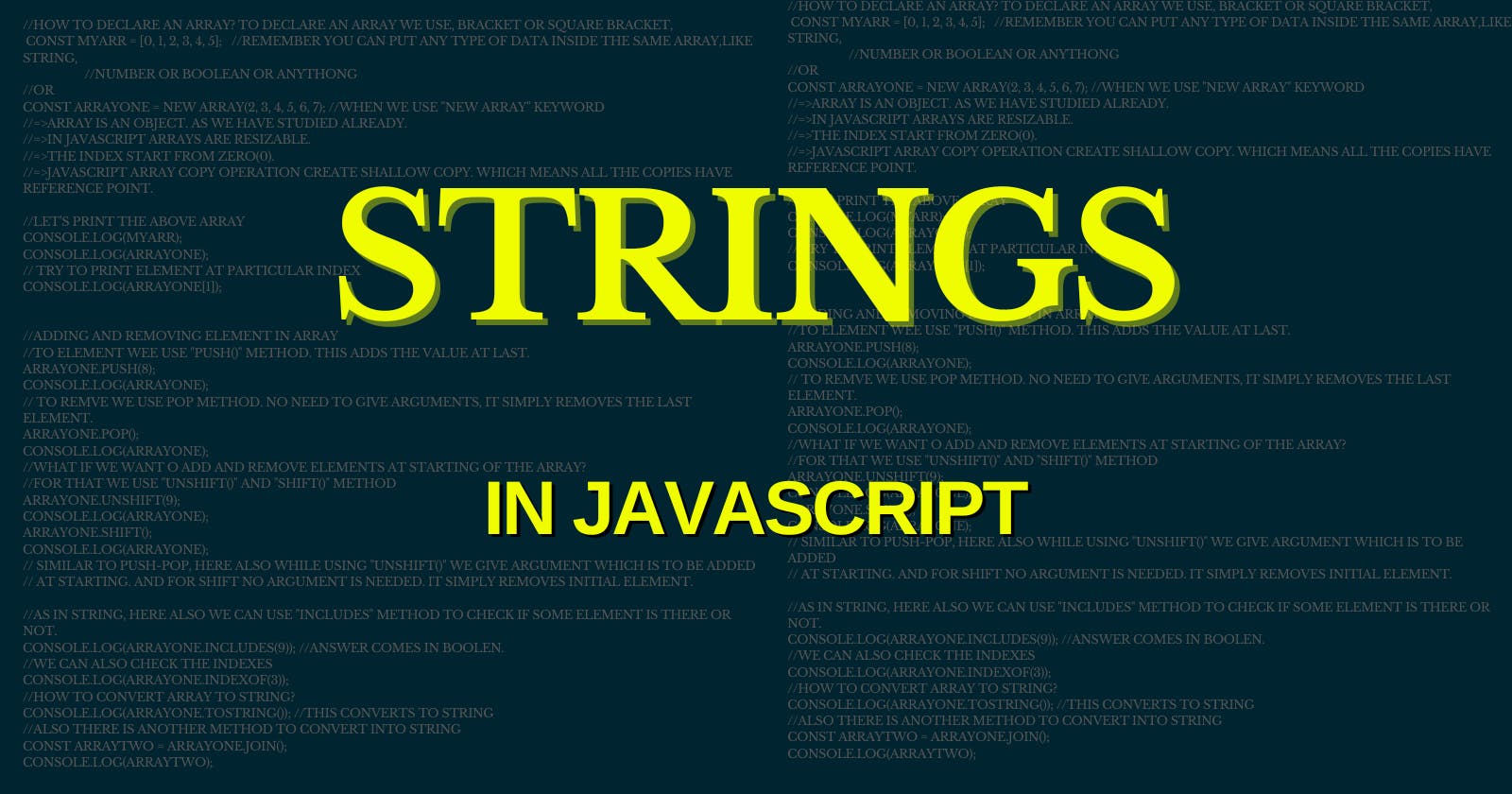Table of contents
Strings are one of the fundamental data types in JavaScript, and they play a crucial role in any programming language. In JavaScript, strings are used to represent and manipulate text. In this article, we will explore everything you need to know about strings in JavaScript, from creating and manipulating strings to working with advanced string methods.
What is a String?
A string in JavaScript is a sequence of characters enclosed in either single (' '), double (" "), or backticks (` ` ) quotes. These characters can be letters, digits, symbols, or even spaces. Here are some examples of strings:
const str1 = 'Hello, World!';
const str2 = "JavaScript is awesome!";
const str3 = `I love coding.`;
Creating Strings
JavaScript provides multiple ways to create strings:
1. Single or Double Quotes
You can use single or double quotes to create a string:
const singleQuotes = 'This is a string with single quotes.';
const doubleQuotes = "This is a string with double quotes.";
2. Template Literals
Template literals, introduced in ES6, allow you to create strings with embedded expressions. These strings are enclosed in backticks (` ` ):
const name = 'Alice';
const greeting = `Hello, ${name}!`;
3. String Constructor
You can also create a string using the String constructor:
const str = new String('Hello from the String constructor!');
While using the String constructor is less common for creating strings, it's essential to be aware of it.
String Properties
Strings in JavaScript have several properties, but two of the most commonly used ones are:
length: This property returns the number of characters in the string.
const str = 'JavaScript';
console.log(str.length); // 10
constructor: This property returns a reference to the constructor function that created the string.
const str = 'Hello, World!';
console.log(str.constructor); // [Function: String]
String Methods
JavaScript provides a wide range of built-in methods to manipulate and work with strings. Here are some of the most commonly used string methods:
1. Concatenation
You can concatenate (combine) strings using the + operator or the concat() method:
const str1 = 'Hello';
const str2 = 'World';
const result = str1 + ' ' + str2; // Using the + operator
const concatenated = str1.concat(' ', str2); // Using the concat() method
2. Accessing Characters
You can access individual characters in a string using bracket notation or the charAt() method:
const str = 'JavaScript';
const firstChar = str[0]; // Using bracket notation
const secondChar = str.charAt(1); // Using charAt() method
3. Substrings
To extract a portion of a string, you can use the substring(), slice(), or substr() methods:
const str = 'Hello, World!';
const substring = str.substring(0, 5); // "Hello"
const sliced = str.slice(7, 12); // "World"
const substr = str.substr(7, 5); // "World"
4. Searching and Replacing
You can search for substrings within a string and replace them using methods like indexOf(), lastIndexOf(), search(), and replace():
//indexOf()
const text = 'JavaScript is a programming language. JavaScript is powerful.';
const indexOfJS = text.indexOf('JavaScript');
console.log(indexOfJS); // Output: 0 (index of the first occurrence)
//lastIndexOf()
const lastIndexOfJS = text.lastIndexOf('JavaScript');
console.log(lastIndexOfJS); // Output: 31 (index of the last occurrence)
//search()
const searchJS = text.search(/JavaScript/i); // Case-insensitive search
console.log(searchJS); // Output: 0 (index of the first match)
//replace()
const newText = text.replace(/JavaScript/g, 'JS'); //global replacement
console.log(newText);
// Output: 'JS is a programming language. JS is powerful.'
5. Case Conversion
JavaScript provides methods to convert the case of characters within a string:
const str = 'Hello, World!';
const uppercase = str.toUpperCase(); // "HELLO, WORLD!"
const lowercase = str.toLowerCase(); // "hello, world!"
6. Splitting and Joining
You can split a string into an array of substrings using split(), and you can join an array of strings into a single string using join():
const sentence = 'JavaScript is fun';
const words = sentence.split(' '); // ["JavaScript", "is", "fun"]
const joined = words.join('-'); // "JavaScript-is-fun"
String Escaping
Sometimes, you may need to include special characters within a string. To do this, you can use escape sequences. Common escape sequences include:
\n: Newlineconst newlineExample = 'Line 1\nLine 2'; console.log(newlineExample); // Output: // Line 1 // Line 2\r: Carriage returnconst carriageReturnExample = 'Hello, World!\rOverwritten Text'; console.log(carriageReturnExample); // Output: // Overwritten Text, World!\t: Tabconst tabExample = 'Name:\tJohn Doe'; console.log(tabExample); // Output: // Name: John Doe\\: Backslashconst backslashExample = 'Path: C:\\Program Files\\Example'; console.log(backslashExample); // Output: // Path: C:\Program Files\Example\': Single quoteconst singleQuoteExample = 'Don\'t forget'; console.log(singleQuoteExample); // Output: // Don't forget\": Double quote
const doubleQuoteExample = "He said, \"Hello!\"";
console.log(doubleQuoteExample);
// Output:
// He said, "Hello!"
String Immutability
Strings in JavaScript are immutable, meaning their values cannot be changed once they are created. Any operation that appears to modify a string, such as concatenation or replacing, actually creates a new string.
let str = 'Hello';
str = str + ', World!'; // Creating a new string
Conclusion
Understanding strings is fundamental to programming in JavaScript. With this knowledge, you can manipulate text, parse data, and work with user inputs effectively. Whether you're building a web application, processing data, or creating games, strings are a vital part of your JavaScript toolkit. Explore and experiment with the various string methods to become proficient in using them, and you'll be well-equipped to handle text-based tasks in your JavaScript projects.
